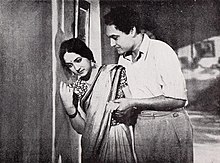Mumtaz Shanti
Mumtaz Shanti | |
|---|---|
 Shanti posing for a publicity poster in 1943 | |
| Born | Mumtaz Begum 28 May 1926 |
| Died | 19 October 1994 (aged 68) |
| Other names | The Jubilee Girl[1] |
| Occupation | Actress |
| Years active | 1937 - 1983 |
| Spouse | Wali Sahib (husband) |
| Children | Sikander Wali (son) Zafar Iqbal (son) |
Mumtaz Shanti (28 May 1926 – 19 October 1994) was an actress in pre-partition Indian cinema.[1] Working in Bollywood films of the 1940s and also the early 1950s, she moved to Pakistan after the partition of India and retired from her entertainment career.
She was known as "The Jubilee Girl" because of her roles in films Basant (1942) and Kismet (1943).[1] She worked in films including Mangti (1942), Basant (1942), Badalti Duniya (1943), Kismet (1943), Dharti (1946), Ghar Ki Izzat (1948) and Aahuti (1950).[2]
Early life
Mumtaz was born in 1926 in Dinga, in the Gujrat District of the Punjab Province of British India into a Punjabi Muslim family. Mumtaz's mother died when she was very young and her aunt took care of her.[1] Mumtaz's uncle encouraged her to learn singing and dancing when she was visiting Lahore Walli Sahab spotted her and then she went to Calcutta and worked in Sohni Kumharan in 1937.[1]
Career

Mumtaz Shanti's career peaked in the 1940s and early 1950s with hit movies like Basant (1942), Kismet (1943) with Ashok Kumar, Badalti Duniya and Dharti with Trilok Kapoor, and Ghar Ki Izzat (1948) with a young Dilip Kumar.[3][2][4][5]

Kismet was the biggest hit of her career.[6][7][8] The film starring her and Ashok Kumar broke all previous records when it came to box office revenues.[2][1] It ran for a record three years at Kolkata’s Roxy cinema. This record was broken 32 years later by Sholay.[9]
Personal life
Mumtaz Shanti was married to Walli Sahab, a film director and writer in pre-partition Bollywood then after partition they both moved to Pakistan in the early 1950s and Sahab died of heart failure in 1977.[1]
Mumtaz Shanti died in Pakistan on 19 October 1994.[2]
Filmography
Film
| Year | Film | Language |
|---|---|---|
| 1937 | Sohni Kumharan | Punjabi[1] |
| 1940 | Chambe Di Kali | Punjabi |
| 1942 | Mangti | Punjabi[1] |
| 1942 | Basant | Hindi[10][1] |
| 1943 | Sawaal | Hindi |
| 1943 | Badalti Duniya | Hindi[1] |
| 1943 | Kismet | Hindi[11][1] |
| 1944 | Bhartruhari | Hindi |
| 1944 | Lady Doctor | Hindi |
| 1944 | Pagli Duniya | Hindi |
| 1945 | Chand Chakori | Hindi |
| 1946 | Dharti | Hindi |
| 1946 | Magadhraj | Hindi |
| 1946 | Pujari | Hindi |
| 1946 | Shravan Kumar | Hindi |
| 1947 | Diwani | Hindi |
| 1947 | Doosri Shadi | Hindi |
| 1948 | Ghar Ki Izzat | Hindi[3] |
| 1948 | Heer Ranjha | Hindi |
| 1948 | Padmini | Hindi |
| 1949 | The Honor of the House | Hindi |
| 1950 | Aahuti | Hindi |
| 1950 | Biwi | Hindi |
| 1950 | Putli | Hindi |
| 1952 | Sanskar | Hindi |
| 1952 | Zamane Ki Hawa | Hindi[1] |
| 1975 | Aakraman | Hindi |
| 1983 | Chatpati | Hindi |
References
- ^ a b c d e f g h i j k l m "Mumtaz Shanti – Interview". Cineplot.com website. 20 August 2016. Archived from the original on 3 July 2019. Retrieved 11 December 2022.
- ^ a b c d "Profile of Mumtaz Shanti". Cineplot.com website. 21 June 2014. Archived from the original on 4 July 2019. Retrieved 11 December 2022.
- ^ a b "Ghar Ki Izzat (1948)". Hindi Geet Mala website. Archived from the original on 7 August 2020. Retrieved 11 December 2022.
- ^ One Hundred Indian Feature Films: An Annotated Filmography. Routledge. p. 109.
- ^ Bless You Bollywood!: A Tribute to Hindi Cinema on Completing 100 Years. p. 108.
{{cite book}}:|website=ignored (help) - ^ Bollywood: A Guidebook to Popular Hindi Cinema. Routledge. p. 145.
- ^ Routledge Handbook of Indian Cinemas. Routledge. p. 165.
- ^ Encyclopaedia of Hindi Cinema. p. 446.
{{cite book}}:|website=ignored (help) - ^ "Kismet: The biggest blockbuster before 'Sholay'". The Times of India. Retrieved 6 April 2021.
- ^ Bollywood's Top 20 Superstars of Indian Cinema. p. 115.
{{cite book}}:|website=ignored (help) - ^ Encyclopedia of Indian Cinema. Oxford University Press. p. 293.
